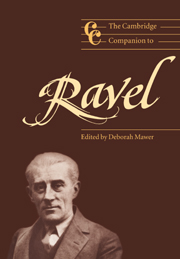Book contents
3 - Musical objects and machines
from Part I - Culture and aesthetic
Published online by Cambridge University Press: 28 September 2011
Summary
Ravel was a decorative artist of the highest order, defining and elaborating musical objects and images which exert a continuing fascination.
hopkinsBut over all would be the triumph of the machine, the vast monster that man has created to do his bidding.What a noble inspiration!
ravelAn important part of Ravel's compositional aesthetic is bound up with objectification, crystallisation and detachment, ideas that connect with Symbolist notions of imagery, Cubist notions of spatial and temporal planes and, beyond World War I, with the basic tenets of neoclassicism. Musical machines or mechanisms represent a particular embodiment of this aesthetic, and so this chapter probes Stravinsky's commonly invoked image of ‘the most perfect of Swiss clockmakers’. Although ideas of musical objects and machines are closely related (even interlocked), for the sake of clarity, and in keeping with the artificial subject-matter, they are here explored successively rather than simultaneously.
Ravel's objectivity and ‘l'objet juste’
Beyond the elusive essentials of inspiration and imagination, composition for Ravel involved a life-long striving for the highest technical achievement: ‘conscience compels us to turn ourselves into good craftsmen. My objective, therefore, is technical perfection.’ Ravel then goes a step further: ‘The truth is one can never have enough control. Moreover, since we cannot express ourselves without exploiting and thus transforming our emotions, isn't it better at least to be fully aware and acknowledge that art is the supreme imposture?’ As a subsidiary non-musical pursuit, Ravel also had a passion for collecting meticulously honed objects at his small house in Montfort-l'Amaury: glass ornaments, figurines, clocks and mechanical toys.
- Type
- Chapter
- Information
- The Cambridge Companion to Ravel , pp. 47 - 68Publisher: Cambridge University PressPrint publication year: 2000
- 6
- Cited by

